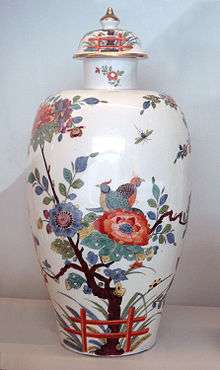Chelsea porcelain factory

The Chelsea porcelain manufactory (established around 1743-45) is the first important porcelain manufactory in England;[1] its earliest soft-paste porcelain, aimed at the aristocratic market—cream jugs in the form of two seated goats—are dated 1745. The entrepreneurial director was Nicholas Sprimont, a silversmith by trade, but few documents survive to aid a picture of the manufactory's history. Early tablewares, being produced in profusion by 1750, depend on Meissen porcelain models and on silver prototypes, such as salt cellars in the form of realistic shells.
Chelsea was known for its figures. From about 1760 its inspiration was drawn more from Sèvres porcelain than Meissen.
In 1769 the manufactory was purchased by William Duesbury, owner of the Derby porcelain factory, and the wares are indistinguishable during the "Chelsea-Derby period" that lasted until 1784, when the Chelsea factory was demolished and its moulds, patterns and many of its workmen and artists transferred to Derby.
The factory history can be divided into four main periods, named for the identifying marks under the wares:
Triangle period (around 1743-1749)
These early products bore an incised triangle mark. Most of the wares were white and were strongly influenced by silver design. The most notable products of this era were white saltcellars in the shape of crayfish. Perhaps the most famous pieces are the Goat and Bee jugs in 1747 that were also based on a silver model. Copies of these were made at Coalport in the 19th century.
Raised anchor period (1749-1752)
In this period, the paste and glaze were modified to produce a clear, white, slightly opaque surface on which to paint. The influence of Meissen, Germany is evident in the classical figures among Italianate ruins and harbour scenes and adaptations from Francis Barlow's edition of Aesop's Fables. In 1751, copies were made of two Meissen services. Chelsea also made figures, birds and animals inspired by Meissen originals. Flowers and landscapes were copied from Vincennes.
Red anchor period (1752-1756)
Kakiemon (Japanese pottery), subjects were popular from the late 1740s until around 1758, inspired by the original Japanese and then by Meissen and Chantilly. Some English-inspired tableware decorated with botanically accurate plants, copied from the eighth edition of Philip Miller's The Gardener's Dictionary (1752) were also produced in this period.
Gold anchor period (1756-1769)
The influence of Sèvres was very strong and French taste was in the ascendancy. The gold anchor period saw rich coloured grounds, lavish gilding and the nervous energy of the Rococo style. In the 1750s and 1760s, Chelsea was also famous for its toys, which included bonbonnières, scent bottles, étuis, thimbles and small seals, many with inscriptions in French. In 1769 the failing factory was purchased by William Duesbury of Derby who ran it until 1784; during this time the Chelsea wares are indistinguishable from Duesbury's Derby wares and the period is usually termed "Chelsea-Derby".
Gallery
-

Goat-and-Bee Jug, c. 1745-1749, Birmingham Museum of Art
-

A Lady, c. 1755
-
c. 1755-56
-

A Shepherdess, c. 1760
-

A Street Vendor, c. 1760
-
.jpg)
Porcelain inkstand, 1759-1769. The Walters Art Museum.
Notes
- ↑ The Bow factory was granted a patent in 1744 but no examples of its wares predating the first works of Chelsea porcelain are known.
External links
- "Derby Porcelain Factory (Chelsea-Derby Period)". Cleveland Museum of Art. Retrieved 2010-07-11.
- "Listing of Anchor marks". International Ceramics Directory.
References
- F. Severne McKenna, Chelsea Porcelain: The Red Anchor Wares, 1951.
- F. Severne McKenna, Chelsea Porcelain: The Gold Anchor Wares, 1952.

